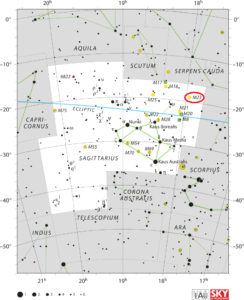Messier 25 contains 601 known members. The cluster is home to two giant stars of the spectral type G and appears to contain two M-class giants which are not really members of the cluster. With an estimated age of 90 million years, M25 is not a particularly young star cluster.
| Description | |
| Visible From Pacific Northwest | Summer Months |
| Best Time To Observe | June and July |
| Minimum Size Of Viewing Device | Small Telescope |
| Object Type | Open Cluster |
| Designations | Messier 25, M25, IC 4725, Collinder 382, Melotte 204, C 1828-192, MWSC 2940 |
| Right Ascension | 18h 31.6m |
| Declination | 19°15′ |
| Constellation | Sagittarius |
| Number Of Stars | 601 |
| Apparent magnitude | 4.6 |
| Apparent dimensions | 32′ |
| Object Radius | 10 light years |
| Distance From Earth | 2,000 light years |
History
The cluster was discovered by the Swiss astronomer Jean-Philippe Loys de Chéseaux in 1745. De Chéseaux observed, “Another one between the bow and the head of Sagittarius, of which RA is about 274d 17′ and southern declination is 19d 11′ 30″.”
Charles Messier included the cluster in his catalogue on June 20, 1764. This is how he described M25:
A cluster of small stars in the neighborhood of the two previous clusters [M23 and M24], between the head & the end of the bow of Sagittarius: the nearest known star to this cluster is 21 Sagittarii, 6th magnitude, according to Flamsteed. The stars of this cluster are seen with difficulty with an ordinary telescope of 3.5-foot [FL]; no nebulosity can be seen. Its position has been determined from Mu Sagittarii. (diam. 10′)
Locating M25 In The Sky
Messier 25 is pretty easy to locate with binoculars. It lies 6.5 degrees north and a little east of Lambda Sagittarii (Kaus Borealis), the star that marks the top of the Teapot asterism in Sagittarius. The cluster appears brighter and larger than the nearby Messier 23 and is positioned only 3.5 degrees to the west of the much larger Messier 24, the Sagittarius Star Cloud.

Viewing M25
It is visible to the naked eye under good conditions, with clear, dark skies and no light pollution. Messier 25 is best seen in small telescopes. The brightest stars are resolved in 10×50 binoculars, but the cluster only appears as a dim patch of light. Small telescopes will reveal a large group of 30 stars, most of them white in colour, while larger instruments (8-inch and up) will show about 60 stars of different colours.
Photographing M25
We did find some that suggest using 30 second exposures at f/2.8 and an ISO of 800 would work well. Others will utilize a combination of 8 images at 60 seconds, each with an ISO of 1600. The timing will vary, but autoguiding is crucial to making sure that crips stars are in the images.
http://www.astro-pat.com/MessierList/M25-081707.htm
Sources And Further Reading
Descriptions of all of Messier Objects can be found here.
https://freestarcharts.com/messier-25

Be the first to comment on "Messier 25"